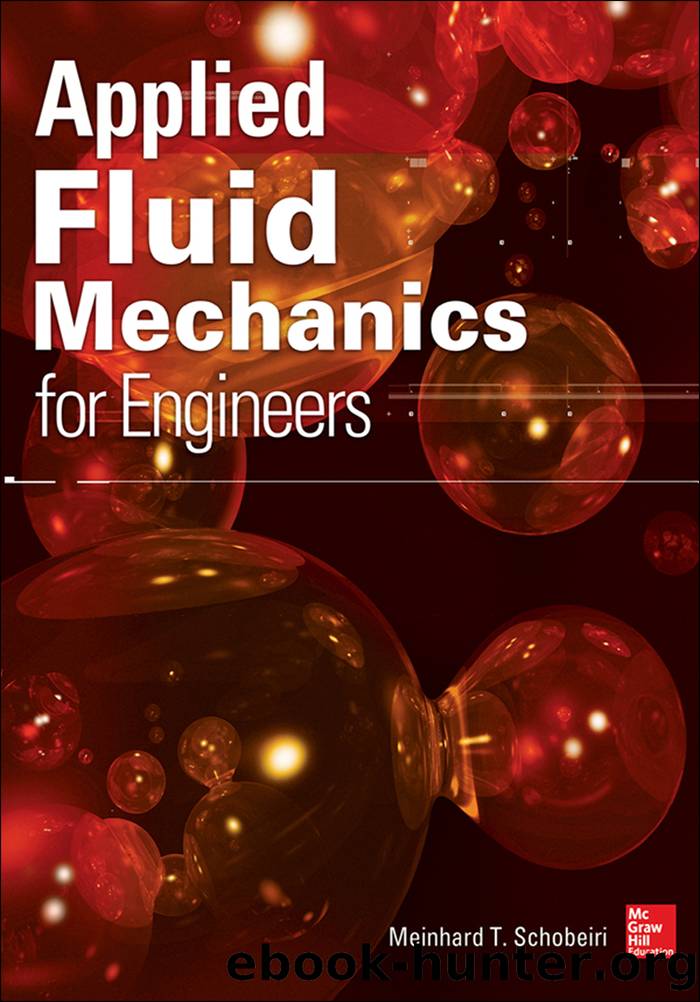Applied Fluid Mechanics for Engineers by Schobeiri Meinhard T

Author:Schobeiri, Meinhard T.
Language: eng
Format: epub
Tags: -
Publisher: McGraw-Hill Education
Published: 2014-01-26T16:00:00+00:00
9.1.2 Correlations, Length, and Time Scales
As we saw in Chap. 8, the Reynolds-averaging procedure has created an apparent stress tensor, , with nine components from which, for symmetric reasons, six are distinct. Thus, the creation of this tensor has added six more unknowns to Navier-Stokes equations. In order to find additional equations to close the equation set that consists of continuity, momentum, and energy balances, we need to construct additional equations. This is done by multiplying the i-th component of the Navier-Stokes equation with the j-th one. Thereby we expect to find turbulence models that establish relations between the new equations and the set of equations mentioned above. It should be pointed out that this purely mathematical manipulation does not represent any new conservation law with a physical background. However, it helps in providing additional tools that are necessary for turbulence modeling. In this context, correlations are indispensable tools for providing additional insight into turbulence. As we know from Navier-Stokes equations, the second-order tensor is the mean product of the fluctuation components at a single point in space; it is called a single-point correlation. It does not give any further information about the turbulence structure, such as the length and time scales of eddies. We obtain this information from a two-point correlation. It is a second-order tensor of the mean product of fluctuation components at two different points in space and time, namely (x,t) and (x + r, t + Ï). For a purely spatial correlation with Ï = 0, the same fluctuating quantity is measured at two different spatial positions, x and x + r. Figure 9.2 shows the position of the fluctuation components for a single-point correlation and several two-point correlations. For a general two-point correlation, we construct the second-order tensor:
Download
This site does not store any files on its server. We only index and link to content provided by other sites. Please contact the content providers to delete copyright contents if any and email us, we'll remove relevant links or contents immediately.
Whiskies Galore by Ian Buxton(41524)
Introduction to Aircraft Design (Cambridge Aerospace Series) by John P. Fielding(32883)
Small Unmanned Fixed-wing Aircraft Design by Andrew J. Keane Andras Sobester James P. Scanlan & András Sóbester & James P. Scanlan(32569)
Craft Beer for the Homebrewer by Michael Agnew(17927)
Turbulence by E. J. Noyes(7690)
The Complete Stick Figure Physics Tutorials by Allen Sarah(7135)
Kaplan MCAT General Chemistry Review by Kaplan(6589)
The Thirst by Nesbo Jo(6432)
Bad Blood by John Carreyrou(6271)
Modelling of Convective Heat and Mass Transfer in Rotating Flows by Igor V. Shevchuk(6219)
Learning SQL by Alan Beaulieu(6029)
Weapons of Math Destruction by Cathy O'Neil(5822)
Man-made Catastrophes and Risk Information Concealment by Dmitry Chernov & Didier Sornette(5641)
Digital Minimalism by Cal Newport;(5388)
Life 3.0: Being Human in the Age of Artificial Intelligence by Tegmark Max(5182)
iGen by Jean M. Twenge(5155)
Secrets of Antigravity Propulsion: Tesla, UFOs, and Classified Aerospace Technology by Ph.D. Paul A. Laviolette(4974)
Design of Trajectory Optimization Approach for Space Maneuver Vehicle Skip Entry Problems by Runqi Chai & Al Savvaris & Antonios Tsourdos & Senchun Chai(4837)
Electronic Devices & Circuits by Jacob Millman & Christos C. Halkias(4739)
